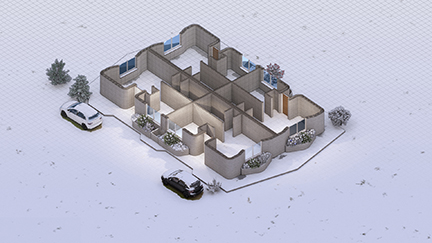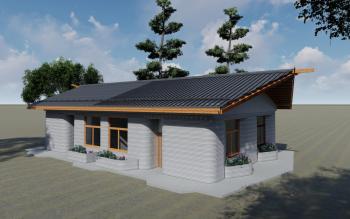Image Caption
Local Journalism Initiative Reporter
Windspeaker.com
Work on the foundations has already begun and by Oct. 16 the printer will begin running on the 3D concrete layers that will be used to construct four fourplexes on the Siksika Nation.
“I've been thinking about using the technology to build housing out here and it sort of went from there and to putting together a proposal and getting funding and then ultimately starting to build the project,” said Ryan Hall, housing manager of Siksika Housing on the southern Alberta First Nation.
3D concrete printing technology—a method to create a three-dimensional object layer-by-layer--has been around for about a decade, he says. In the last few years, it has become more commercially viable.
This past summer, Hall began talking with nidus3D, a Kingston, Ont.-based company that does 3D construction. On the strength of that partnership, the University of Calgary School of Architecture and Planning was drawn into the project and the three worked together to develop the 16 transitional units.

Kakatoosoyiists, which means Star Lodges, will be the largest 3D concrete printed housing project in Alberta.
The 3D printer operates on site. A robotic arm, directed by railings that have been installed on site, layers the concrete where it is required. The exterior walls will be laid on top of a concrete slab-on-grade foundation.
Hall said they had considered using the 3D technology for interior walls, as well, but opted to go with conventional walls inside. It’s less print time, he says, and saves money.
The print time to do the exterior walls is about one week per building.
Electrical, plumbing, windows and finishing work will then be undertaken.
“We're still trying to figure out some supply chain issues to acquire materials, but I think in the new year, they'll be ready. Our contract requires that they are done by March 31,” said Hall.
Kakatoosoyiists will consist of 16 one-bedroom-one-bathroom units grouped in fourplexes. Each unit will be about 600 square feet. They will serve as homes for single or double occupation. Double occupation could be partners or a mother and child.
As transitional homes, they could be occupied from six months to two years, says Hall.
The units are intended for Nation members who are experiencing a housing crisis, whether they are moving back from Calgary because they can no longer afford the rent or they are fleeing domestic violence.
“Whatever it is, they’ll have supports in place that could be done through home visitation or maybe providing them a service (to help) them move into permanent housing,” said Hall.
As for permanent housing, Hall says that’s a three-to-five-year plan which will see Siksika Nation build three- or four-bedroom homes.
There is a possibility that 3D printed concrete technology could be used there too as it would provide a faster turn around. A company can be hired to do the work or the Nation could look at undertaking the work itself.
“I would consider this a pilot project,” said Hall. “And one of the ideas is, if it makes sense to us after we're done, and I've done sort of an analysis on this, maybe the nation would buy a machine and actually design and build our own housing.”
Using their own design will allow Siksika Nation to incorporate Blackfoot knowledge, which is exactly what Kakatoosoyiists has done with Elder Eldon Weasel Child having input.
The roof is designed to look like a tipi, with wood beams projecting like tipi poles. Inside, there are interior spaces in the bedrooms to accommodate sacred bundles as sacred bundle holders may someday be residents. There is also a gathering area off the main entrance.
Hall says their innovative construction project is garnering some attention from Indigenous communities in Alberta, especially, because they are able to get input from Elders to design the homes, which is not something that can be done with prefabricated homes.
3D printing technology also provides for a sustainable way of building as it minimizes waste, reduces carbon emissions, and utilizes locally sourced materials.
Hall says he had no problems convincing chief and council to embrace the cutting-edge technology, especially since service sites were already available. A band council resolution was required for the funding application.
The project is funded at $2.6 million from Indigenous Services Canada.
Local Journalism Initiative Reporters are supported by a financial contribution made by the Government of Canada.

